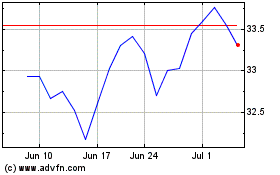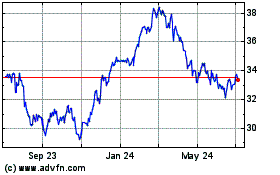Bronx Warehouse's Answer to Truck Congestion: Its Own Rail Link
February 20 2020 - 5:59AM
Dow Jones News
By Keiko Morris
The developer of a four-story warehouse in the South Bronx plans
to include a freight-rail connection in the project to address
trucking costs and traffic congestion associated with the
e-commerce boom.
Turnbridge Equities expects to break ground this fall on what
would be the only multistory New York City distribution center
designed with a rail spur linking it to a rail network run by CSX
Corp.
At the Bronx Logistics Center, the spur would allow freight to
enter the warehouse grounds by train, whereas most New York City
warehouses rely entirely on truck delivery.
The push for faster delivery, the rise in online shopping --
including food orders -- and the city's population growth have
driven companies to seek distribution operations within the five
boroughs to be closer to their customers.
Truck congestion and delays resulted in $862 million in lost
economic activity for the city in 2017, according to a report by
the New York City Economic Development Corp. That figure could rise
to $1.1 billion annually by 2045 if no measures are taken to
address the issue, the EDC said. The city's economic development
arm is pushing for more investment in rail and maritime freight
transportation.
"As trucks clog the road and there's more traffic, people are
going to look to logistics solutions that can solve that problem,"
said Ryan Nelson, a Turnbridge managing principal. "And this is one
of them."
Mr. Nelson and his partner Andrew Joblon said they were
negotiating a construction contract for the $700 million
development. They want to attract e-commerce sellers, food
distributors and other tenants.
While the Bronx Logistics Center wouldn't be the first warehouse
in the city to offer rail service, it would be one of the few with
the amenity.
Railcars carry about 2% of the city's overall freight, according
to the city's Economic Development Corporation.
About 5% of potential tenants now looking for space want it to
have direct rail service, according to JLL, a real-estate services
firm that is advising Turnbridge on the Bronx Logistics Center
project.
Typically, companies looking for direct freight-rail service are
those receiving raw goods and products such as food or beverages
that are heavy and would be less expensive to transport long
distances by rail than by truck, real-estate consultants said.
But the types of companies interested in warehouse access to
rail service are starting to expand, the consultants said. A
truck-driver shortage has added to rising freight costs. The
increased expenses and shorter delivery-time requirements are
pushing companies to consider shipping more products by rail.
The number of train cars transported by barge from trains at New
Jersey terminals to Brooklyn rose 25% between 2017 and 2018,
according to the city's economic development corporation.
"Rail was used more for raw materials and goods before the
recession," said James Breeze, global head of industrial logistics
research at real estate services firm CBRE Group Inc. "Today it is
more diverse and more about lower costs and distributing rather
than just moving larger raw materials."
Turnbridge's 1.24 million square-foot project is set to rise on
five parcels of land adjacent to Oak Point Yard, a rail yard that
also services the Hunts Point Cooperative Market Inc. The first
three floors will have ramp access and loading docks for 53-foot
trucks. Vans and smaller trucks will be able to access the fourth
floor by ramps, and the warehouse will have 1,400 parking
spaces.
The project is one of about six, modern, multistory warehouses
in the city either under construction or in the planning stages.
With little land available in New York to build more distribution
centers, the developers are betting warehouse tenants will be
willing to pay a premium on rent to be close to their New York City
customers and to save on delivery costs from distribution centers
outside the city.
"Being closer to the consumer is the name of the game," said Rob
Kossar, a vice chairman at JLL. "Your rent is higher but
transportation costs go down so significantly that it offsets the
higher rental rate."
Write to Keiko Morris at Keiko.Morris@wsj.com
(END) Dow Jones Newswires
February 20, 2020 05:44 ET (10:44 GMT)
Copyright (c) 2020 Dow Jones & Company, Inc.
CSX (NASDAQ:CSX)
Historical Stock Chart
From Mar 2024 to Apr 2024

CSX (NASDAQ:CSX)
Historical Stock Chart
From Apr 2023 to Apr 2024
